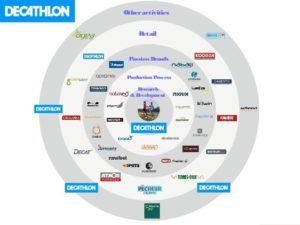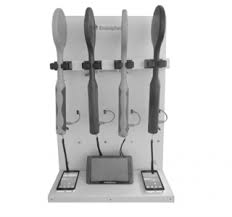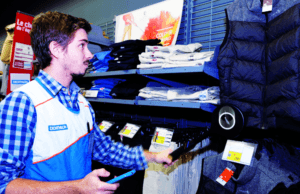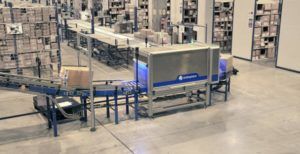Sport retailer knows how to swing the racquet

RFID is not a new but its widespread use is. Decathlon shows how a retailer can integrate vertically into technology driving efficiency for all stakeholders.
Decathlon is a private French sport retailer turning around $10bn sales (65% international), employing 70,000 people in ~ 1,200 stores[1]. The customer value proposition focused on all year long affordable quality multisport offering. Its second market is China. Quite impressive in the world first manufacturing market!
Decathlon achieved this through a fully vertically integrated business model. To guarantee affordability, it developed its own white label products creating one brand for each sport, sitting next to international brands. Internally-developed products are not cheap low quality knockoffs, there is genuine innovation: 620 R&D employees![2] For instance, Decathlon pioneered the 2s tent or foldable ping pong tables. The result? Private label accounts for a staggering ~80% of sales.

But where does Digital play?

So, how does Decathlon/Embisphere use technology to develop their business?
 If you are walking in a Decathlon store, you would see employees strolling down the aisles with a small black racquet slightly larger than a table tennis one. It is not a new product. It is the fastest way to account for inventory. Given the large proportion of private label SKUs, Decathlon could take the dramatic step to equip all its products with RFID. The “source tagging” is done at the production site with 35 RFID manufacturing offices directly supplying ~1,000 manufacturing suppliers. Traditional retailers with wide sourcing could hardly force such a change. As a closed loop retailer, Decathlon could jump to Full RFID: a step change supply chain improvement. It launched global RFID roll-out in 4 months only.
If you are walking in a Decathlon store, you would see employees strolling down the aisles with a small black racquet slightly larger than a table tennis one. It is not a new product. It is the fastest way to account for inventory. Given the large proportion of private label SKUs, Decathlon could take the dramatic step to equip all its products with RFID. The “source tagging” is done at the production site with 35 RFID manufacturing offices directly supplying ~1,000 manufacturing suppliers. Traditional retailers with wide sourcing could hardly force such a change. As a closed loop retailer, Decathlon could jump to Full RFID: a step change supply chain improvement. It launched global RFID roll-out in 4 months only.
Does it make a difference? According to Decathlon, 2% of sales, i.e. $200m+[5]. What a hit!
For full transparency, it seems that Decathlon may have copied the technology from an entrepreneur[6] it was partnering with. This should serve as a cautionary tale for start-ups partnering with large companies… Retail is somehow always a balance of power!
Nevertheless, the move to full RFID offers tremendous opportunities. What changed in practice?
- Ultra-fast stock count throughout point of sales, warehouses and logistic
- Seamless register check-out given all products are instantly recognized without scanning
Daily inventory management becomes simpler[7]: improved traceability, no need to open cartons, theft reduction, improve inventory location throughout stores allowing more reliable store pickups, faster POS data increase marketing flexibility, quicker audit… The benefits are so wide that it is hard to measure benefit. As for all new technology the S curve adoption drives price erosion. A label now costs $5cts[8] against a $3cts for widely used EAS technology.
RFID implementation yields three direct benefits:
- Sales increase from better availability of products because more frequent inventory update
- Margin optimization from lower markdowns by operating an absolutely exhaustive workflow control
- More efficient operations in shops and logistic, from faster, safer and more reliable checkouts
In 2016, Decathlon received the Best RFID implementation Award[9].



Beside logistics, what are the next steps?
First, digital technology creates social transformation in the shop. With the employees’ time spent at the cash register or counting stocks removed, released labor capacity can be reallocated to other tasks. For instance, employees spend more time talking about their own sport practice improving service and driving sales. So employees and customers’ satisfaction are both increasing in a virtuous circle!
Second, the customer experience can be dramatically improved from precise localization and more articles’ details. Marketing teams’ creativity can be reinvigorated as new possibilities are offered: playing a music or a video in fitting rooms linked to the articles tried, removing the need to keep purchase receipts as unique labels could trace back purchases, washing machines recognizing the care notice and adjusting programs…
Third, technology improvements will increase efficiency. Scanning will improve through video[10]. Labels themselves will get lighter, more flexible coupled with more memory and potentially sensors[11].
(800 words)
[1] http://corporate.decathlon.com/en/who-are-we/key-figures/
[2] Decathlon Corporate Innovation http://corporate.decathlon.com/nos-innovations/recherche-et-developpement/
[3] http://www.embisphere.com/en/tags
[4] RFID labels, Modern Materials Handling, Nov 30, 1999, Vol.54(12), p.134 [Peer Reviewed Journal]
[5] http://www.rfidjournal.com/articles/view?13815
[6] http://www.capital.fr/enquetes/hommes-et-affaires/decathlon-lui-a-t-il-vole-son-invention-1148244
[7] Tech Partnership Looks Beyond the Bar Code With Digital Watermarks, WSJ By LORETTA CHAO Jan. 12, 2016
[8] http://www.filrfid.org/article-oxylane-decathlon-tague-85-de-ses-articles-avec-la-rfid-uhf-epc-121563932.html
[9] http://ieee-sensors2016.org/
[10] Camera-assisted localization of passive RFID labels, Indoor Positioning and Indoor Navigation (IPIN), 2012 International Conference on, Issue Date: 13-15 Nov. 2012, Written by: Nick, T.; Cordes, S.; Gotze, J.; John, W.
[11] Lowry, Intermec by Honeywell – White Paper – Are you realizing the Full Benefits of RFID, December 2013



During our two years living in Spain we visited Decathlon several times. It’s a great store and many of my coworkers shopped there often as well. The employee availability was amazing – we bought 4 bicycles and throughout the process one young man helped us understand what was available and best suited each of our kids. If that was a direct result of RFID employment improving employee availability to serve customers, the impact is real and amazing.
My hesitance is customers’ willingness to procure products into which RFID tags are inextricably sown or manufactured. When word gets out that Decathlon can track every time you visit the store (and moreover that RFID could be used to track the item by anyone anywhere with the right data and scanner) I’m concerned that customers will push back strongly. I would! But I also really want that new backpack…
Decathlon is for me one of the brands that has built the strongest reputation for its white label products. However, my experience at the store has not always been the best – huge “warehouses” in which it is hard to find what you are looking for, with few employees available to help you. I am skeptical about the effect of using RFID will have on the customers’ experience, as I expect even less employees to be around as this technology spreads to all Decathlon’s stores, and I wonder what was the true reason behind Decathlon’s investment in this new technology. In my opinion, investments that would improve the customers’ experience in the store would have more impact.
Thanks for this Artatak. I’ve heard that RFID and beacons can be used for inventory management but thought it was still very expensive and far off from reality – so cool to hear that Decathlon is already using them.
I’m not as concerned about the privacy issues, as Luke is, because as I interpret this, the RFID is simply embedded into the item’s tag which customers can remove when they purchase the item, and even if a customer is carrying an item around the store, the store doesn’t have information about who the customer is. I disagree with Joana’s point above, because although I have not visited a Decathlon store before, I do think that freeing up employees time in the store should enable them to have more time to speak with customers.
I wonder if this will become widespread. Here, it is effective because 80% of Decathlon’s sales are private label, but there was a common language or product that was used by multiple manufacturers given the structure of a typical retail store. If I were Decathlon, I would think about how they can market this RFID technology to other manufacturers – while it is a competitive advantage now in terms of inventory management, there is a huge business opportunity if this can be used by other suppliers and retailers.